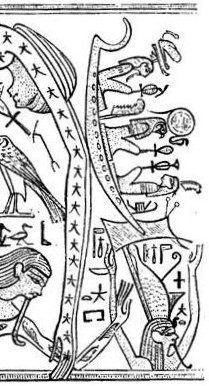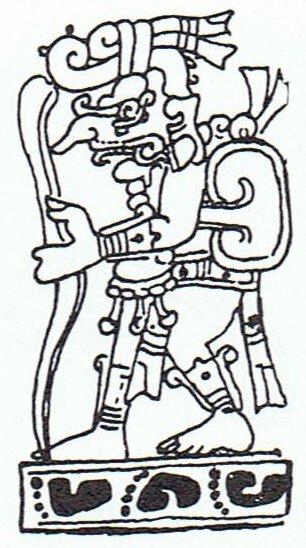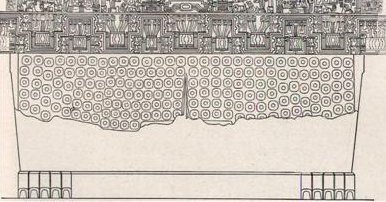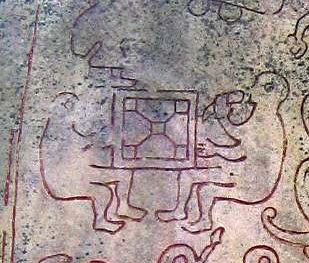On Easter Island there were very few species of mammals
and the Chinese pair of zodiacal structures with beasts living on the
surface of Mother Earth could not be applied without
radical
changes.
They seem to have decided to let the life cycles
taken onboard the Ship of the King (Hotu A Matua)
had better be primarily described by species of
plants and birds.
|
Te Takapau |
TE UHI (water yam roots) stolen by
Teke from his brother Ma'eha: |
|
SIRRA H
(*0) |
18 |
ADHIL
(*19) |
13 |
MIRA
(*33) |
7 |
BHARANI
(*41) |
|
ALCHITA
(*183) |
SPICA
(*202) |
KHAMBALIA
(*216) |
ZUBEN
ELGENUBI (*224) |
|
0h |
39 |
|
Sweet Potatoes (he kumara) given by Bau to
Oti: |
|
1 |
*42 |
he hiva matua |
a Bau. a Oti. |
|
2 |
*43 |
he hiva poki |
|
3 |
*44 |
he renga moe tahi teatea |
|
4 |
*45 |
he renga moe tahi uriuri |
|
5 |
*46 |
he uru omo. |
|
6 |
*47 |
he ree aniho. |
|
7 |
*48 |
he ha.u pu.uriuri |
|
8 |
*49 |
he ha.u.pu.teatea |
|
9 |
*50 |
he okeoke |
|
10 |
*51 |
he apuka. |
|
11 |
*52 |
he ure vai. |
|
12 |
*53 |
he paiki. |
|
13 |
*54 |
he uriuri. |
|
14 |
*55 |
he piu tahi. |
|
15 |
*56 |
he tuitui koviro. |
|
16 |
*57 |
he aro piro. |
|
17 |
*58 |
he pekepeke mea. |
|
18 |
*59 |
he pekepeke uri. |
|
19 |
*60 |
he aringa rikiriki. |
|
20 |
*61 |
he tua tea. |
|
20 |
BEID |
he mamari kiakia. |
|
Mamari.
Egg, fish roe. mÔmari ata rauhau,
last small egg laid by a hen before she
turns broody. Vanaga. Egg (of fowl or
fish), (gamamari), (Cf. komari.);
mamari punua, chicken in the
shell. Churchill.
Mgv.: kiakia, the cry of the
kotake (a white marine bird.)
Take. The Marquesans are the only
people who own to a distinctive national
name, and retain a tradition of the road
they travelled from their original
habitat, until they arrived at the
Marquesan Islands. They call themselves
te Take, 'the Take
nation'. Fornander. Take,
Tuvaluan for the Black Noddy (Anous
Minutes). The specific epithet
taketake is Māori for long
established, ancient, or original. In
the Rapa Nui mythology, the deity
Make-make was the chief god of
the birdman cult, the other three gods
associated with it being
Hawa-tuu-take-take (the Chief of the
eggs) his wife Vie Hoa and Vie
Kanatea. Wikipedia |
|
he maika
(bananas) |
|
- |
origo |
he ri'o |
|
1 |
*1 |
he koro tea. |
a Teke. a Oti. |
|
2 |
*2 |
he hihi. |
|
3 |
*3 |
he pukapuka. |
|
4 |
*4 |
he pia. |
|
5 |
*5 |
he nahoo. |
|
Maika.
Banana (Musa
sapientum). Ancient varieties were
called ri'o, hihi, korotea, pia,
pukapuka, naho'o. Vanaga. Meika,
banana. Pau., Mgv.: meika,
id. Mq.: meika, meia, id.
Ta.: meia, id.
Churchill. |
|
- |
origo |
1 he
koro tea. |
2 he hihi. |
3 he
pukapuka. |
|
Koro. 1. Father
(seems to be an older word than
matu'a tamÔroa). 2. Feast, festival;
this is the generic term for feasts
featuring songs and banquetting; koro
hakaopo, feast where men and women
danced. 3. When (also: ana koro);
ana koro oho au ki Anakena, when I
go to Anakena; in case, koro
haga e ţa, in case he wants
it. Vanaga. If. Korokoro, To
clack the tongue (kurukuru).
Churchill. Ma.: aokoro, pukoro,
a halo around the moon. Vi.: virikoro,
a circle around the moon. There is a
complete accord from EfatÚ through Viti
to Polynesia in the main use of this
stem and in the particular use which is
set to itself apart. In EfatÚ koro
answers equally well for fence and for
halo. In the marked advance which
characterizes social life in Viti and
among the Maori the need has been felt
of qualifying koro in some
distinctive manner when its reference is
celestial. In Viti virimbai has
the meaning of putting up a fence (mbai
fence); viri does not appear
independently in this use, but it is
undoubtedly homogenetic with Samoan
vili, which has a basic meaning of
going around; virikoro then
signifies the
ring-fence-that-goes-around, sc. the
moon. In the Maori, aokoro is the
cloud-fence. Churchill 2. |
|
MARCH
20 (*364) |
0h |
22
(*1) |
23 |
24
(83) |
 |
no glyph |
 |
 |
 |
|
Gb8-30 (242) |
Ga1-1 |
Ga1-2 |
Ga1-3 |
|
Al Dabarān-2 (The Follower)
HYADUM I
= γ Tauri
(63.4)
*22.0 = *63.4 - *41.4 |
HYADUM II
= δ╣ Tauri
(64.2) |
Net-19 (Crow)
AIN
(Eye) =
ε Tauri,
θ╣
Tauri,
θ▓
Tauri (65.7) |
no star listed (66) |
no star listed (67) |
|

...
There was no water in the village. The
lakes and rivers were dry. Raven and
Crow, two young girls who were having
their first menstrual courses, were told
to go and draw water from the ocean.
Finding the journey too long, Raven
decided just to urinate into her
basket-bucket. She decieved no one and
was severly scolded. Crow returned much
later but with drinking water. As a
punishment, Raven was condemned never to
find water in the summer; only in winter
would she find something to drink. For
that reason the Raven never drinks
during the hot months; she speaks with a
raucous voice because of her dry throat
... |
|
May 23 |
24 |
25 (145) |
26
(*66) |
27 |
|
░May
19 |
20 |
21 (*61) |
22 (142) |
23 |
|
'April 26 |
27 |
28
(118) |
29
(*39) |
30 |
|
"April 12 |
13 |
14
(104) |
15
(*25) |
16
(471 = 314 * 1Ż) |
|
CLOSE
TO THE FULL MOON: |
|
SEPT 19 |
20 (*183) |
21
(264) |
EQUINOX |
23 |
|
YED POSTERIOR (Hand Behind) =
ε
Ophiuchi,
RUKBALGETHI SHEMALI
(Northern Knee of the Giant) =
τ
Herculis
(246.6).
δ
Apodis (246.7),
ο
Scorpii (246.8) |
Heart-5 (Fox)
σ Scorpii
(247.0),
HEJIAN = γ Herculis
(247.2),
ψ
Ophiuchi (247.7) |
ρ
Ophiuchi (248.1),
KAJAM (Club)
=
ω
Herculis
(248.3),
χ
Ophiuchi (248.5),
SHE LOW (Market Tower) = υ Ophiuchi,
Tr.
Austr. (248.7), ζ Tr. Austr. (248.8) |
Al Kalb-16 (The Heart) /
Jyeshtha-18 (Eldest) /
ANA-MUA-1 (Entrance pillar)
ANTARES
= α Scorpii
(249.1),
MARFIK (Elbow) = λ Ophiuchi,
φ Ophiuchi (249.5), ω Ophiuchi (249.8) |
γ Apodis (250.1), σ Herculis (250.3), θ
Tr. Austr. (250.6), τ Scorpii (250.7) |
|
...
Proclus informs us that the fox star
nibbles continuously at the thong of the
yoke which holds together heaven and
earth; German folklore adds that when
the fox succeeds, the world will come to
its end. This fox star is no other than
Alcor, the small star g near zeta
Ursae Majoris (in India Arundati,
the common wife of the Seven Rishis,
alpha-eta Ursae
...
 |
|
Nov 22 |
23 (327) |
24 |
25 (*249) |
26 |
|
░Nov 18 |
19 |
20 (*244) |
21 (325) |
22 |
|
'Oct
26 |
27 (300) |
28 |
29
(*222) |
30 |
|
"Oct
12 |
13 (286) |
14 |
15
(*208) |
16 |
 |
|
4 he pia. |
5 he nahoo. |
|
|
Naholoholo
('Swift-running') |
|
MARCH 25 (84) |
26 (*5) |
27 |
 |
 |
 |
|
Ga1-4 |
Ga1-5 |
Ga1-6 |
|
Rohini-4 (The Red One) /
Pidnu-sha-Shame-4 (Furrow of Heaven)
/
ANA-MURI-2 (Rear pillar - at the
foot of which was the place for
tattooing)
ALDEBARAN
= α Tauri
(68.2),
THEEMIN = υ▓ Eridani
(68.5) |
no star listed (69) |
no star listed (70) |

On Tahiti Aldebaran was named
Ana-muri (star pillar at the
end - presumably of summer) and as a
further clue it was stated that here
(when the Sun reached the 'foot' of
Aldebaran) was the place for
tattooing → darkening as observed
from a place south of the equator.
Rigel ('Foot') was at the foot of Orion
(as perceived from a place in the north), i.e.
we can interpret 'foot' as
corresponding to time zero (origo) - where
Land (to walk on) in the sky dome
had arrived. Here time was moving
quickly (naholoholo)
in contrast to at the solstices.
 |
|
May 28 (148) |
29 (88 + 61) |
30 (*70) |
|
░May 24 (144) |
25 (*65) |
26 |
|
'May 1 (121) |
2
(*42) |
3 |
|
"April 17 (107) |
18 (*28) |
19 |
|
CLOSE
TO THE FULL MOON: |
|
SEPT 24 (84 + 183) |
25 (*188) |
26 |
|
HAN = ζ Ophiuchi
(251.0) |
ζ
Herculis,
η
Tr. Austr.
(252.1), η Herculis, β Apodis
(252.5) |
ATRIA
=
α
Tr. Austr.
(253.9) |
|
JULY 2 (183) |
83 |
SEPT 24 (267) |
 |
 |
|
11h (167.4)
χ Leonis, χ╣ Hydrae
(167.1), χ▓ Hydrae
(167.3)
*167.4 - *41.4 = *126.0 |
HAN = ζ Ophiuchi
(251.0) |
|
|
Nov 27 |
28 |
29 (333) |
|
░Nov 23 |
24 (*248) |
25 (329) |
|
'Oct 31 (*225) |
'Nov 1 |
2
(306) |
|
"Oct 17 (*210) |
18 |
19 (292) |
The sweet potatoes were arranged so they would
stretch to the beginning of the front side of the
year (as regarded from a point north of the equator
- in Hiva).
Counting
from the stone statue Te-taka-pau (cfr
Hanga-te-pau) viz. the Navel-of-the-horse (i.e.
Sirrah = the Topknot of Tara-ga),
Pau. 1. To run out (food, water): ekˇ pau
te kai, te vai, is said when there is an
abundance of food or water, and there is no fear of
running out. Puna pau, a small natural well
near the quarry where the 'hats' (pukao) were
made; it was so called because only a little water
could be drawn from it every day and it ran dry very
soon. 2. Va'e pau, clubfoot. Paupau:
Curved. Vanaga. 1. Hakapau, to pierce (cf.
takapau, to thrust into). Pau.: pau, a
cut, a wound, bruised, black and blue. 2. Resin.
Mq.: epau, resin. Ta.: tepau, gum,
pitch, resin. (Paupau) Hakapaupau, grimace,
ironry, to grin. 3. Paura (powder),
gunpowder. 4. Pau.: paupau, breathless. Ta.:
paupau, id. 5. Ta.: pau, consumed,
expended. Sa.: pau, to come to an end. Ma.:
pau, finished. 6. Ta.: pau, to wet one
another. Mq.: pau, to moisten. Churchill.

the right ascension day distance
was *64. But there were 3 stars (Adhil, Mira,
Bharani) which were so important they broke the
sequence, and therefore the measure of items which
were primarily brought
onboard became 1 (stone statue) + 39 (yams) + 21 (sweet potatoes) =
61, i.e. the same as the number of holes in the
center of a Chinese board of checkers:
61 (holes) + 6 * 10 (coloured balls) = 121 (= 11 *
11) like the
day number when the Sun reached Bharani (at the time
of rongorongo), viz. in May 1.
According to Barthel the basic Easter Island month
for planting sweet potatoes was April, corresponding
to October north of the equator. 4 (April) + 12 / 2 = 10
(October), but 8 (octo) - 6 = 2. Or rather 12 + 8 -
6 = 14 = 12 + 2 (February).
|
In Barthel 2 a summary is
given over the months on Easter Island
(according to the structure of a modern
calendar). I have adapted the table
somewhat.
Red
means the 6 months when sun is
'present': |
|
1st quarter |
2nd quarter |
3rd quarter |
4th quarter |
|
He Anakena
(July) |
Tagaroa uri
(October) |
Tua haro
(January) |
Vaitu nui
(April) |
|
Same
as the previous month. |
Cleaning up of the fields. Fishing is no
longer taboo. Festival of thanksgiving (hakakio)
and presents of fowl. |
Fishing. Because of the strong sun very
little planting is done. |
Planting of sweet potatoes. |
|
Hora iti
(August) |
Ko Ruti
(November) |
Tehetu'up˙
(February) |
Vaitu potu
(May) |
|
Planting of plants growing above
the ground (i.e., bananas, sugarcane,
and all types of trees).
Good time to fish for eel
along the shore. |
Cleaning of the banana plantations, but
only in the morning since the sun
becomes too hot later in the day.
Problems with drought. Good month for
fishing and the construction of houses
(because of the long days). |
Like
the previous month. Some sweet potatoes
are planted where there are a lot of
stones (pu). |
Beginning of the cold season. No more
planting. Fishing is taboo, except for
some fishing along the beach. Harvesting
of paper mulberry trees (mahute).
Making of tapa capes (nua). |
|
Hora nui
(September) |
Ko Korˇ
(December) |
Tarahao
(March) |
He Maro
(June) |
|
Planting of plants growing below
the ground (i.e., sweet potatoes, yams,
and taro).
A fine spring month. |
Because of the increasing heat, work
ceases in the fields. Time for fishing,
recreation, and festivities. The new
houses are occupied (reason for the
festivities). Like the previous month, a
good time for surfing (ngaru) on
the beach of Hangaroa O Tai. |
Sweet
potatoes are planted in the morning;
fishing is done in the afternoon. |
Because of the cold weather, nothing
grows (tupu meme), and there is
hardly any work done in the fields. Hens
grow an abundance of feathers, which are
used for the festivities. The time of
the great festivities begins, also for
the father-in-law (te ngongoro mo te
hungavai).
There is much singing (riu). |
|
The spelling of the names
of the months are according to Vanaga. |
This idea to illustrate number of days by species of
buried (covered up) potatoes was not an isolated
instance:
... Once upon a time there was an
old woman who owned a great potato field where she
planted her potatoes in spring and harvested them in
autumn. She was famous all around for her many
varieties of wonderful potatoes, and she had enough
of them to sell at the market place.
She planted her potatoes 7 in a
row, placing her foot in front of her as a measure
from one potato to the next. Then she marked the
place with a bean - which would also give
nourishment to the surrounding potatoes. Next she
changed variety and planted 7 more followed by
another bean, and this was the pattern she followed
until all her 214 varieties had been put down in
their proper places. She had drawn a map which she
followed and from where each sort of potato could be
located at the proper time for its harvest. I was
fashinated, when I happened to stumble on this
Swedish TV program, because my 'once upon a time'
was now and 214 (= 2 * 107) was surely no
coincidence. She knew what she was doing. Let's
therefore count: 214 * 7 (potatoes) + 213 (beans) =
1711. So what? Probably because 1711 = 59 * 29 ...
At the back side of the stone
statue of Mother Earth in South
America we have found 214 as the sum of 182 and
32:
|
Counting in the tresses
of Pachamama from right to left: |
|
1 |
26 |
78 |
1 |
29 |
90 |
|
2 |
26 |
2 |
30 |
|
3 |
26 |
3 |
31 |
|
4 |
25 |
104 |
4 |
34 |
124 |
|
5 |
26 |
5 |
31 |
|
6 |
27 |
6 |
30 |
|
7 |
26 |
7 |
29 |
|
Total = 396 = 182 + 214
(= 364 + 32) |
... The number written in stone
in the tresses on the back of Pachamama (the
World Mother) is 182 (→ 364 / 2) + 214 (→ 2-14 or
February 14, the day of 'All Hearts') = 396. And 214 - 182 = 32 ...
... The tresses of Pachamama
(the World Mother) can be counted as 182 + 214 = 396
and her trousers can be counted as 177 (= 354 / 2)
...

|












